Once upon a time 'way back in the mid-1970s, there was a popular recording duo called "The Captain & Tennille." These two--an electronic keyboardist (whose almost-unbelievable real name was Daryl Dragon) and wife Toni Tennille (a tall, vivacious songstress)--soared to the top of the pop charts with such sensuous songs as "Lonely Night" and "The Way That I Want To Touch You," as well as the bouncy "Love Will Keep Us Together." Critics said that Toni Tennille could get your attention with almost any set of lyrics, which certainly must have been the case when she warbled a chart-busting little ditty about two semi-aquatic rodents named "Muskrat Suzie" and "Muskrat Sam." Here at Hilton Pond Center we don't think often about The Captain and Tennille--or Sam and Suzie for that matter--but we hadn't much choice this week when we actually got to observe what Toni Tennille once sang so passionately about, i.e., "Muskrat Love."
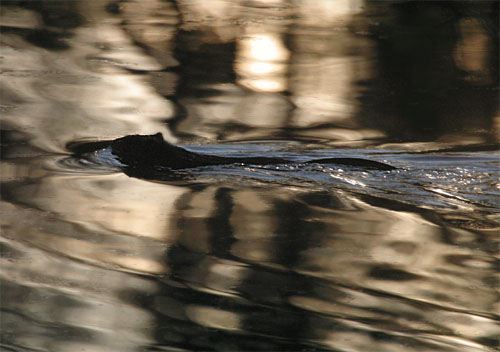
All text & photos © Hilton Pond Center
Of all the songs released by The Captain and Tennille, surely "Muskrat Love" was their most unusual and, thus, most memorable--so no wonder its verses came to mind this week while we walked the shores of Hilton Pond. As mentioned in last week's installment, late in the day on 12 March we spotted a Muskrat plying the pond's surface (below left)--not an unusual occurrence in the Carolina Piedmont except that we hadn't seen one locally for perhaps a decade. Their absence was on-going good news because in the 1980's the pond was practically swarming with Muskrats, and they were doing their collective best to dig tunnels around its perimeter--including burrows that threatened to undermine the dam that retains Hilton Pond.  We fretted over the Muskrat's potentially destructive digging behavior and even had to fill in one den that caused the top of the dam to collapse--very nearly creating a new spillway. We fretted over the Muskrat's potentially destructive digging behavior and even had to fill in one den that caused the top of the dam to collapse--very nearly creating a new spillway.
In about 1996 or so, Muskrats began disappearing from Hilton Pond and the larger impoundment below it--apparently when a family of River Otters, Lutra canadensis, took up temporary residence three winters in a row. The otter and its close relative, the Mink (Mustela vison), are likely the Muskrat's main natural enemies, and it didn't take long for our visiting otters to decimate the Muskrat population. We haven't seen the otters for several years, so it may be that their absence has allowed wandering Muskrats to return.

Muskrats, Ondatra zibethicus, are so-called because of odoriferous glands near the genital region in both males and females; the musk apparently is used to communicate in ways that only Muskrats understand. Mammalogists have determined through field study that there's no particular social structure among a Muskrat colony, with individuals acting pretty much independently for most of the year. A male usually remains with the same female for lengthy periods, resulting in at least a degree of monogamy.
Muskrats have a huge distribution, being found almost everywhere in North America from extreme northern Mexico to most of Alaska; within the continental U.S. Muskrats are absent only from the coastal regions of the Carolinas and Georgia, all of Florida, and the southwestern deserts. 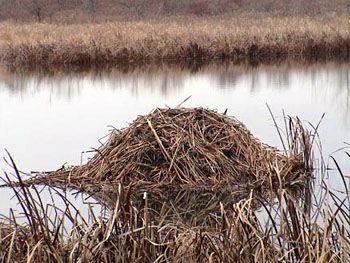 In deep lakes or ponds and slow-moving rivers and streams Muskrats tend to be bank-nesters, while in shallow lakes--especially those with ample amounts of emergent vegetation--they often build dome-shaped lodges similar to those of Beavers. The big difference is that Muskrat houses are made of reed, rush, and cattail (above left), while Beavers mostly use tree limbs and twigs. Interestingly, even in lakes where they build lodges, Muskrats may still excavate a lake bed system of tunnels--a network never seen unless the lake is drained. In deep lakes or ponds and slow-moving rivers and streams Muskrats tend to be bank-nesters, while in shallow lakes--especially those with ample amounts of emergent vegetation--they often build dome-shaped lodges similar to those of Beavers. The big difference is that Muskrat houses are made of reed, rush, and cattail (above left), while Beavers mostly use tree limbs and twigs. Interestingly, even in lakes where they build lodges, Muskrats may still excavate a lake bed system of tunnels--a network never seen unless the lake is drained.
Muskrats are well-adapted for a fully aquatic existence. The fur is essentially waterproof--hence its former popularity for Muskrat coats and hats--and the soft underfur keeps the Muskrat (or coat-wearer) warm, even in frigid water. Eyes and external ears are on top of the head and are so small they are no impediment to streamlined movement. The legs are also relatively short--allowing for quick, powerful swimming strokes--and the back feet are heavily webbed and fringed with stiff hairs that help provide additional thrust.
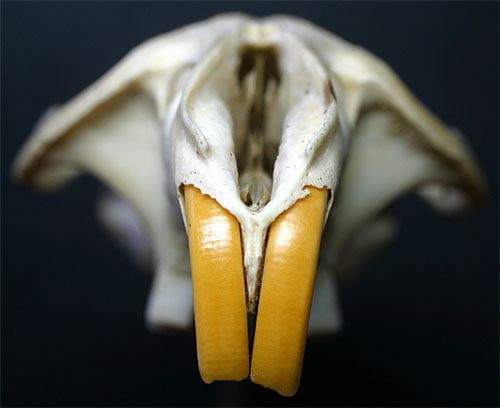
The head of the Muskrat is somewhat compressed top to bottom--another streamlining adaptation, no doubt--and a skull we found several years ago revealed that, like all rodents, Muskrats have a massive pair of upper incisors (above). These are ideally designed for slicing down cattails, bulrushes, and pond weeds they use to build their lodges but that also make up most of the Muskrat's diet. Occasionally Muskrats leave farm ponds to browse on corn and other crops but usually they content themselves with water plants; in the absence of natural forage, they are known to turn carnivorous and eat fish, frogs, crayfish, and freshwater clams.
A layer of hard yellow enamel on the front of a Muskrat's incisor is wear-resistant, while the back of the tooth is much softer and wears faster; this results in an always-sharp chisel-like edge on the tooth. 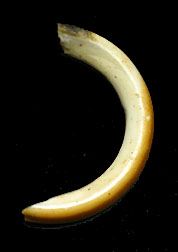 As in other rodents, the Muskrat's incisors continue to grow throughout the life of the individual. As we learned by accident when a front tooth slipped out of the Muskrat skull we found, the curved incisor is exceedingly long--an inch-and-three-quarters from root to tip (right). More than half of this relatively enormous tooth remains hidden within its socket. As in other rodents, the Muskrat's incisors continue to grow throughout the life of the individual. As we learned by accident when a front tooth slipped out of the Muskrat skull we found, the curved incisor is exceedingly long--an inch-and-three-quarters from root to tip (right). More than half of this relatively enormous tooth remains hidden within its socket.
Although Muskrats do leave Hilton Pond to browse, we've seen them out of water less than half a dozen times since 1982. In fact, our usual encounter is to spot them swimming in late afternoon or, more likely, to catch a glimpse of them as they spook and dive from the water's surface, flicking their laterally flattened scaly black tails in a farewell wave. That's why we were especially surprised this week to see a rather industrious Muskrat swimming about on Hilton Pond at midday. As we sat quietly some distance from the water's edge, the Muskrat surfaced from a submerged hole near the roots of a huge White Oak and swam toward a normally dry area that had been flooded by recent rains. It disappeared for a moment into pond-side vegetation and suddenly not one but two Muskrats re-entered the water at that spot. Apparently one of them had been foraging in the shallows and the second came to greet it. What happened next was unexpected, so it was fortunate were carrying our camera with a long lens; regardless, the Muskrats were more than 50 yards across the pond and almost too far away to photograph.
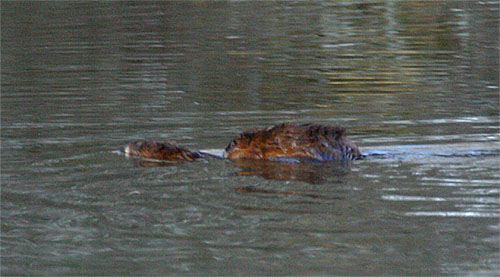
The first Muskrat that dived back into the water was a somewhat smaller animal. Quite obviously, she was a female in heat, for the larger Muskrat began swimming after her and attempted to mount. Over the next five minutes the male swam up close behind the female, pushed down on her hindquarters with his front paws (above), arched his back upwards, and copulated a dozen or so times as they circled slowly around the pond. It was at this point that thoughts of The Captain and Tennille would be likely to enter one's mind--and did; after all, this MUST be what the song means when it refers to "Muskrat Love."
We're guessing the female we observed was indeed in the reproductive mood, for later in the day we saw her swimming toward her underwater den entrance with a snoot full of grasses she would use to line a nest within the burrow (below left). 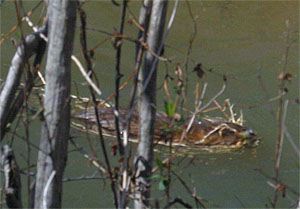 The grasses obviously get wet when she dives with them, so our guess is that within the chamber she licks the material dry before actually placing it in the nest. The grasses obviously get wet when she dives with them, so our guess is that within the chamber she licks the material dry before actually placing it in the nest.
We don't know how often other folks get to observe what that 70s song describes as "Muskrat Love," but such things must go on nearly all the time; from spring through summer the typical Muskrat female has three litters, each containing five to ten kits, so that's a lot of "Muskrat loving." And it's no wonder Muskrats have such a wide distribution, since adolescents are often stressed by overcrowding--especially when habitat is marginal--and many of those offspring end up going off to populate new areas.
One thing we learned this week about Muskrats is that photographing them isn't necessarily easy. The local adults were wary of us as we set up our tripod and long lens, often diving if they saw us getting too close with the camera. They're also most active late in the day when light is not very good for descriptive photography. (The nearly abstract photo at the top of the page, by the way, isn't a sepia-tone illustration; the orange-ish light at sunset just makes it look that way.) Furthermore, Muskrats swim just barely breaking the surface of the water, so they're hard to focus on, and to make matters worse they're almost constantly in motion. Despite these difficulties, we suspect we'll have ample opportunity for more Muskrat photography in the months ahead. Unless the predatory River Otters come back really soon, all that "Muskrat Love" we witnessed this week on Hilton Pond is bound to result in even more ever-lovin' Muskrats--each one potentially photogenic and, in the minds of The Captain and Tennille, worthy of singing about.
All text & photos © Hilton Pond Center
"MUSKRAT LOVE"
Performed by
The Captain AKA Daryl Dragon (electronic keyboard) & Toni Tennille (vocals)
Words & music © 1971 by Willis Alan Ramsay
Photo © Jim McCrary
Muskrat, Muskrat candlelight
Doin' the town and doin' it right
In the evenin'
It's pretty pleasin'
 Muskrat Susie, Muskrat Sam Muskrat Susie, Muskrat Sam
Do the jitterbug out in Muskrat land
And they shimmy
And Sammy's so skinny
And they whirled and they twirled and they tangoed
Singin' and jingin' the jango
Floatin' like the heavens above
It looks like Muskrat love
Nibbling on bacon, chewin' on cheese
Sam says to Susie "Honey, would you please be my missus?"
And she says yes
With her kisses
Now he's ticklin' her fancy
Rubbin' her toes
Muzzle to muzzle, now anything goes
As they wriggle, Sue starts to giggle
And they whirled and they twirled and they tangoed
Singin' and jingin' the jango
Floatin' like the heavens above
It looks like Muskrat love
[Insert The Captain's simulated electronic Muskrat vocalizations here]
And they whirled and they twirled and they tangoed
Singin' and jingin' the jango
Floatin' like the heavens above
It looks like Muskrat love
Do-do-do-do-do, do-do-do-do-do, do-do-do-do-do
[Insert The Captain's simulated electronic horse hoofbeats here,
although we have no idea what they have to do with Muskrats]
-------
NOTE: It has come to our attention that this song was also released by the singing group America in the early 1970s. We've listened to their version but find it inferior to that performed by The Captain & Tennille.
Comments or questions about this week's installment?
Please send an E-mail message to INFO.
NOTE: Be sure to scroll down for an account of all birds banded or recaptured during the week, as well as some other interesting nature notes.
"This Week at Hilton Pond" is written & photographed
by Bill Hilton Jr., executive director of
Hilton Pond Center for Piedmont Natural History.
You may wish to consult our Index of all nature topics covered since February 2000. You can also use the on-line Search Engine at the bottom of this page.
For a free, non-fattening, on-line subscription to "This Week at Hilton Pond," just send us an E-mail with SUBSCRIBE in the Subject line. Please be sure to configure your spam filter to accept E-mails from hiltonpond.org.
|


 We fretted over the Muskrat's potentially destructive digging behavior and even had to fill in one den that caused the top of the dam to collapse--very nearly creating a new spillway.
We fretted over the Muskrat's potentially destructive digging behavior and even had to fill in one den that caused the top of the dam to collapse--very nearly creating a new spillway. 
 In deep lakes or ponds and slow-moving rivers and streams Muskrats tend to be bank-nesters, while in shallow lakes--especially those with ample amounts of emergent vegetation--they often build dome-shaped lodges similar to those of Beavers. The big difference is that Muskrat houses are made of reed, rush, and cattail (above left), while Beavers mostly use tree limbs and twigs. Interestingly, even in lakes where they build lodges, Muskrats may still excavate a lake bed system of tunnels--a network never seen unless the lake is drained.
In deep lakes or ponds and slow-moving rivers and streams Muskrats tend to be bank-nesters, while in shallow lakes--especially those with ample amounts of emergent vegetation--they often build dome-shaped lodges similar to those of Beavers. The big difference is that Muskrat houses are made of reed, rush, and cattail (above left), while Beavers mostly use tree limbs and twigs. Interestingly, even in lakes where they build lodges, Muskrats may still excavate a lake bed system of tunnels--a network never seen unless the lake is drained. 
 As in other rodents, the Muskrat's incisors continue to grow throughout the life of the individual. As we learned by accident when a front tooth slipped out of the Muskrat skull we found, the curved incisor is exceedingly long--an inch-and-three-quarters from root to tip (right). More than half of this relatively enormous tooth remains hidden within its socket.
As in other rodents, the Muskrat's incisors continue to grow throughout the life of the individual. As we learned by accident when a front tooth slipped out of the Muskrat skull we found, the curved incisor is exceedingly long--an inch-and-three-quarters from root to tip (right). More than half of this relatively enormous tooth remains hidden within its socket. 
 The grasses obviously get wet when she dives with them, so our guess is that within the chamber she licks the material dry before actually placing it in the nest.
The grasses obviously get wet when she dives with them, so our guess is that within the chamber she licks the material dry before actually placing it in the nest.  Muskrat Susie, Muskrat Sam
Muskrat Susie, Muskrat Sam

 Oct 15 to Mar 15
Oct 15 to Mar 15
